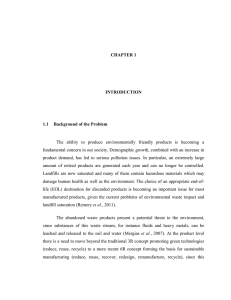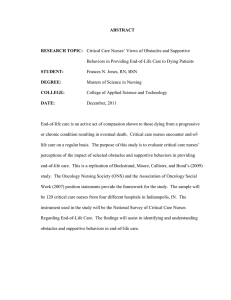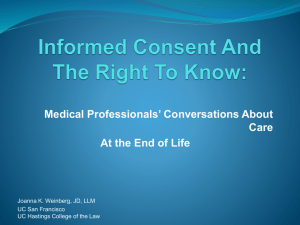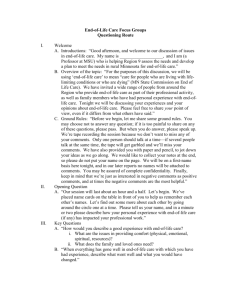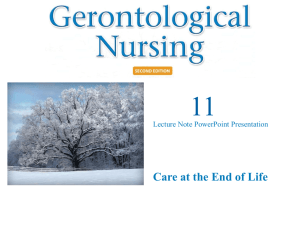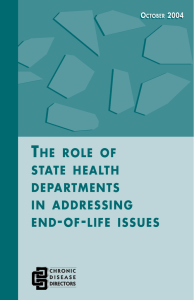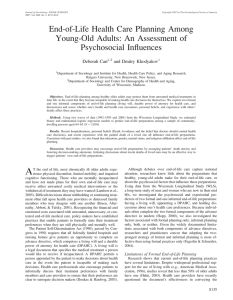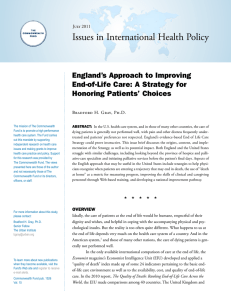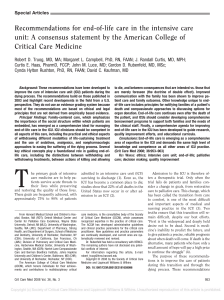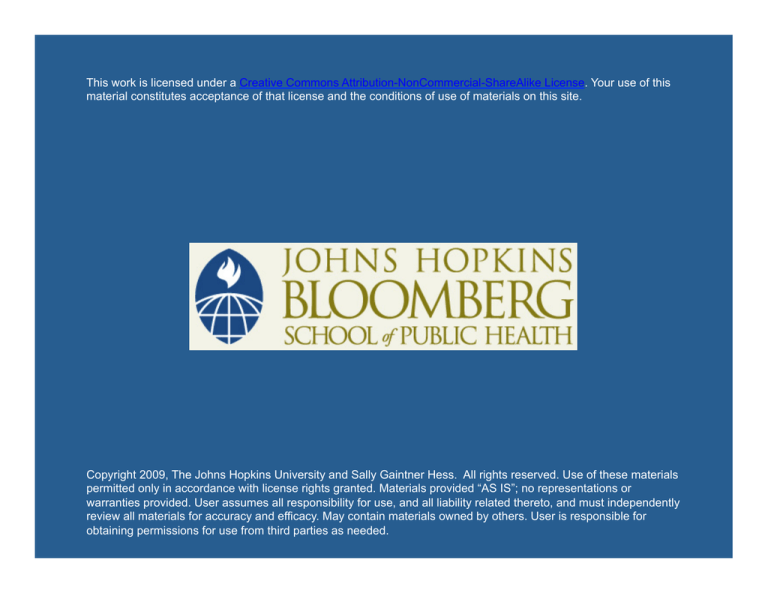
This work is licensed under a Creative Commons Attribution-NonCommercial-ShareAlike License. Your use of this
material constitutes acceptance of that license and the conditions of use of materials on this site.
Copyright 2009, The Johns Hopkins University and Sally Gaintner Hess. All rights reserved. Use of these materials
permitted only in accordance with license rights granted. Materials provided “AS IS”; no representations or
warranties provided. User assumes all responsibility for use, and all liability related thereto, and must independently
review all materials for accuracy and efficacy. May contain materials owned by others. User is responsible for
obtaining permissions for use from third parties as needed.
End-of-Life Care:
A Public Health Call to Action
Sally Gaintner Hess, R.N.
May 9, 2009
Capstone Presentation
Academic & Capstone Advisor:
Dr. George Rebok, Ph.D.
Presentation Outline
Consider the question: Is EOL care a PH problem?
Application of the Problem-Solving Paradigm
•
•
•
•
•
•
•
Problem definition
Magnitude of the problem
Conceptual framework of key determinants
Identifying and developing strategies
Setting priorities and recommending interventions
Implementation and evaluation
Developing a communication strategy
Conclusions
Acknowledgements
Is End-of-Life Care
a Public Health Problem?
If,
Public Health is what we, as a society, do collectively to assure the
conditions in which people can be healthy.1
And,
Health is a state of complete physical, mental, and social well-being
and not merely the absence of disease or infirmity.2
And,
Death has a “universal incidence.”3
Then,
Shouldn’t we, as Public Health, ensure health at the end-of-life?
1IOM (1988). The Future of Public Health 2WHO (1948). Preamble to the Cons6tu6on of the WHO 3Rao, JK, et al. (2002). Am J Prev Med, 23, 215-­‐200 What Does Health at the
End-of-Life Look Like?
Bereavement Care for Loved Ones CuraNve Care PalliaNve Care Time Diagnosed w/ advanced, incurable illness Hospice esNmated <6 mos. to live Death “A Good Death” 1 • Free from avoidable distress and suffering for paNents, families, and caregivers • In general accord with paNents’ and families’ wishes • Reasonably consistent with clinical, cultural, and ethical standards 1IOM (1997). Approaching Death, Improving Care at the end of life Call to AcNon President Obama:
I actually think that the tougher issue
around medical care … is what you do
around things like end-of-life care
I think that there is going to have to be
a conversation that is guided by
doctors, scientists, ethicists .
And public health
Leonhardt, D. After the Great Recession. NY
Times Magazine, April 28, 2009 Problem Definition
At present in the United States, at least half of
all adults experience pain and suffering in the
final months and days of their lives at
excessive financial cost and with intense
resource utilization; and these outcomes
ripple out beyond the dying person to their
families, loved ones, caregivers, and
communities.
Magnitude of the Problem
• Quality of Care: As many as 50% of those with cancer or other
terminal illnesses experience unrelieved pain or other symptoms
during their final days.1
• Cost: Patients with higher costs had worse quality of death in their
final week of life.2
• Impact on Families and Caregivers: Being a caregiver who is
experiencing mental or emotional strain is an independent risk factor
for mortality among elderly spousal caregivers.3
• Access to Services: Despite an overwhelming desire to die at home,
only ¼ of Americans die at home.4
1Rao, JK, et al. (2002). Am J Prev Med, 23, 215-­‐200 2Zhang, B., et al. (2009). Arch Intern Med, 169, 480-­‐488 3Schulz, R. & Beach, SR. (1999). JAMA, 282, 2215-­‐2219 4Grunier, A, et al. (2007). Medical Care Research Review, 64, 351-­‐378. Conceptual Framework of
Key Determinants
Identifying and
Developing Strategies
Assessment Public educaNon PaNent, family, & caregiver educaNon Assurance Professional educaNon Help for paNents, families, and caregivers Access to important/support services Quality of services Policy Development Funding and financial issues Policy and planning Research, epidemiology, and evaluaNon Rao JK, et al. (2005). Am J Prev Med, 29, 453-­‐460 Interven'on Strategies Setting Priorities &
Recommending Interventions
Important role for Public Health
End-of-Life is charged with emotion
Public Health can bring
objectivity,
methodology, and
transparency to the process
Implementation and Evaluation
Developing a
Communication Strategy
How can we communicate with the public
about something nobody wants to talk
about?
The Viagra model?
Conclusions
End-of-Life care IS a public health problem – we must get involved
All of Us
• Educate ourselves
• Talk about dying
• Be sure that our personal wishes for EOL care are known
PH Faculty
• Suggest students use EOL as a project topic to apply learning
• Use EOL as examples in your teachings
PH Practitioners:
• Have you given EOL care consideration in your practice?
Even the Lives of the Dying
Acknowledgements JHBSPH faculty interviewees: • Dr. Jane Bertrand • Dr. Marie Diener-­‐West • Dr. Sydney Dy • Dr. Andrea Gielen • Dr. Robert Lawrence • Dr. George Rebok • Dr. Holly Taylor • Mr. William Ward • Dr. Lawrence Wissow
My Advisor: • Dr. George Rebok • My Family: • David, Sophie, & Eli Hess • Sue Gaintner, Wendy Holcomb, & Jenny Gaintner This project is dedicated to my Dad, Dr. J. Richard Gaintner 1936-­‐2004

